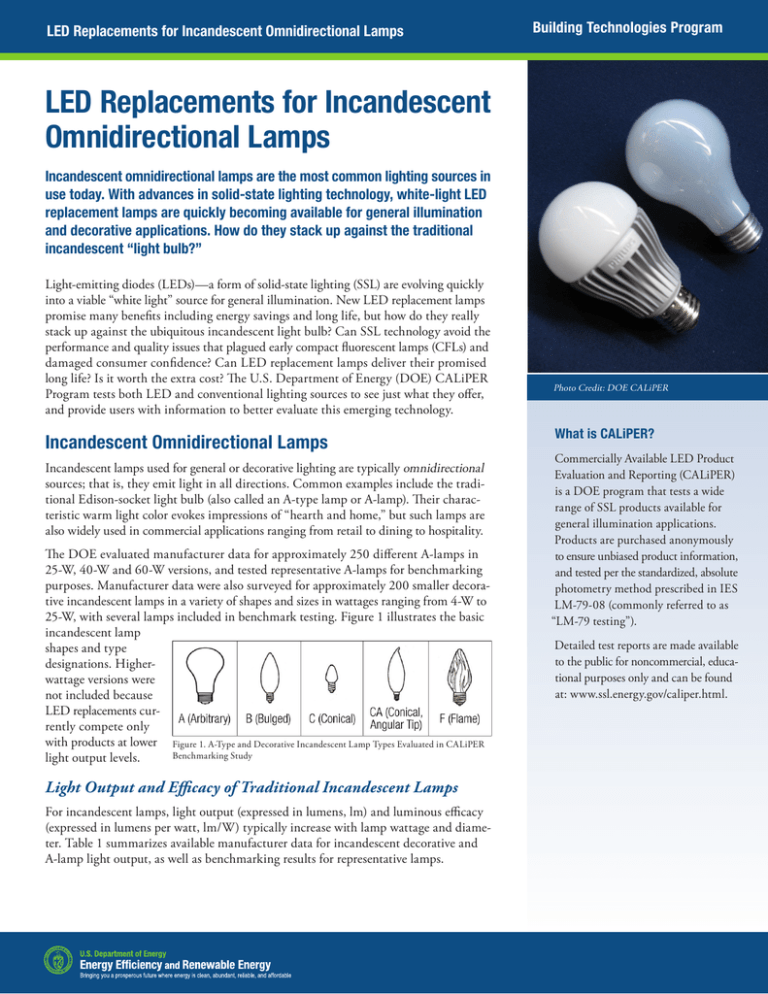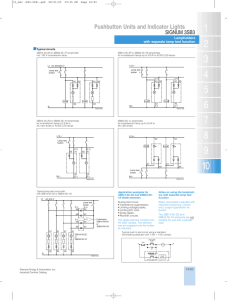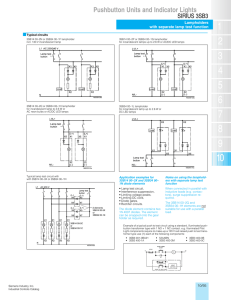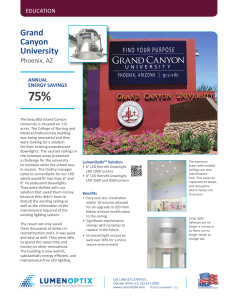LED Replacements for Incandescent Omnidirectional Lamps
advertisement

LED Replacements for Incandescent Omnidirectional Lamps Building Technologies Program LED Replacements for Incandescent Omnidirectional Lamps Incandescent omnidirectional lamps are the most common lighting sources in use today. With advances in solid-state lighting technology, white-light LED replacement lamps are quickly becoming available for general illumination and decorative applications. How do they stack up against the traditional incandescent “light bulb?” Light-emitting diodes (LEDs)—a form of solid-state lighting (SSL) are evolving quickly into a viable “white light” source for general illumination. New LED replacement lamps promise many benefits including energy savings and long life, but how do they really stack up against the ubiquitous incandescent light bulb? Can SSL technology avoid the performance and quality issues that plagued early compact fluorescent lamps (CFLs) and damaged consumer confidence? Can LED replacement lamps deliver their promised long life? Is it worth the extra cost? The U.S. Department of Energy (DOE) CALiPER Program tests both LED and conventional lighting sources to see just what they offer, and provide users with information to better evaluate this emerging technology. Incandescent Omnidirectional Lamps Incandescent lamps used for general or decorative lighting are typically omnidirectional sources; that is, they emit light in all directions. Common examples include the traditional Edison-socket light bulb (also called an A-type lamp or A-lamp). Their characteristic warm light color evokes impressions of “hearth and home,” but such lamps are also widely used in commercial applications ranging from retail to dining to hospitality. The DOE evaluated manufacturer data for approximately 250 different A-lamps in 25-W, 40-W and 60-W versions, and tested representative A-lamps for benchmarking purposes. Manufacturer data were also surveyed for approximately 200 smaller decorative incandescent lamps in a variety of shapes and sizes in wattages ranging from 4-W to 25-W, with several lamps included in benchmark testing. Figure 1 illustrates the basic incandescent lamp shapes and type designations. Higherwattage versions were not included because LED replacements currently compete only with products at lower Figure 1. A-Type and Decorative Incandescent Lamp Types Evaluated in CALiPER Benchmarking Study light output levels. Light Output and Efficacy of Traditional Incandescent Lamps For incandescent lamps, light output (expressed in lumens, lm) and luminous efficacy (expressed in lumens per watt, lm/W) typically increase with lamp wattage and diameter. Table 1 summarizes available manufacturer data for incandescent decorative and A-lamp light output, as well as benchmarking results for representative lamps. Photo Credit: DOE CALiPER What is CALiPER? Commercially Available LED Product Evaluation and Reporting (CALiPER) is a DOE program that tests a wide range of SSL products available for general illumination applications. Products are purchased anonymously to ensure unbiased product information, and tested per the standardized, absolute photometry method prescribed in IES LM-79-08 (commonly referred to as “LM-79 testing”). Detailed test reports are made available to the public for noncommercial, educational purposes only and can be found at: www.ssl.energy.gov/caliper.html. LED Replacements for Incandescent Omnidirectional Lamps Table 1. Manufacturer and Benchmark Data for Incandescent Lamp Light Output Lamp Type & Wattage Decorative lamps A-lamps Manufacturer Rated Light Output Range (lm) Average (lm) Benchmark Testing Results (lm)* 4-W 14 – 16 16 16 (lamp rated @ 16) 7-W 33 – 43 39 27 (lamp rated @ 35) 15-W 85 – 110 98 61 (rated lm not published) 25-W 105 – 220 147 205 (rated lm not published) 25-W 130 – 390 221 181 (lamp rated @ 210) 40-W 240 – 505 405 387 (lamp rated @ 390) 60-W 340 – 1010 698 739 (lamp rated @ 780) *Reported lumen values are from tests of single lamps. For estimating lumen equivalencies among different light source technologies, see Table 2. Regardless of size or wattage, incandescent lamps waste considerable energy in generating light, emitting the wasted energy as heat. Luminous efficacy for typical A19 and A21 lamps does not exceed 15 lm/W. As verified in benchmark testing, efficacies for smaller low-wattage incandescent lamps can be lower than 5 lm/W. LED Replacements for Incandescent Lamps The DOE tested LED replacement lamps to see if they could approximate or match desired characteristics of incandescent omnidirectional lamps, such as light output, distribution, correlated color temperature (CCT) and color rendering index (CRI). As illustrated in Figure 2, available LED A-lamp replacement products span a variety of formats, some with clear bulbs and visible diodes and circuit boards, while others were opaque. All A-lamp replacements were line-voltage products with standard Figure 2. Examples of Bulb Shapes for LED Lamps Replacing Incandescent A-Lamps medium (E26) screw bases. Other LED replacements that were tested fall into the decorative or candelabra-type category (Figure 3). These products had both candelabra (E12) and medium (E26) bases, with clear and frosted bulbs. Figure 3. Examples of Bulb Shapes for LED Lamps Replacing Decorative Incandescent Lamps Light Output and Efficacy Compared to Traditional Lamp Types For A-lamp replacements, the higherperforming LED products had light output comparable to 40-W incandescent products while using considerably less power (approximately 13 W). At around 5 W, LED replacement lamps and CFLs have similar efficacy, and provide about the same light output as 25-W incandescent lamps. Form factor does not generally allow CFLs to replace small, low-wattage Figure 4. Comparison of Initial Light Output and Efficacy for Omnidirectional LED Replacement Lamps and Benchmarked Traditional Lamps (e.g., 4-7 W) decorative incandescent lamps; in comparison, LED replacement lamps are able to fill this product niche while using only about 1 W. Figure 4 illustrates this overlap and separation between LED products and CFLs, depending on the incandescent lamp being replaced. Color Characteristics Standard incandescent lamps produce a characteristic warm, yellowish appearance with a correlated color temperature (CCT) in the 2700–3000 K range and a color rendering index (CRI) of 100, both of which are highly desired by the average consumer. Typical LED products tested were found with both warm (CCT < 3500 K) and cool (CCT > 5000 K) color appearance. Some “white light” LED products emit light that appears bluish, greenish, etc. CALiPER testing shows that these products may have CCT values greater than 8000 K and outside the applicable American National Standards Institute (ANSI) chromaticity specifications for SSL products.1 Color quality can be highly application-specific, and users should not necessarily dismiss an LED product based solely on its measured color characteristics. For example, several LED products had measured CRI values less than 70; however, given the known problems with applying CRI to white light LED products, users should evaluate LED replacement lamps visually to gauge their color rendering for a given application.2 Similarly, an LED product with a higher CCT may not match an incandescent lamp’s warm color, but some users may prefer it for certain visual tasks (e.g., reading), or integrating with other cooler-appearing sources (e.g., fluorescent). Light Direction Unlike an incandescent filament, an LED is an inherently directional light source. However, LEDs can be modified with individual optics and arranged in arrays to approximate the broader light distribution of an incandescent lamp. Figure 5a shows typical omnidirectional distribution of an incandescent A-lamp. Figures 5b and 5c show LED A-lamp replacements with forward output more typical of directional lamps. However, some LED products come close to approximating the omnidirectional distribution of their incandescent counterparts, as shown in Figure 5d. For applications in which the lamp is visible, frosted bulbs help integrate the light output of LED clusters and arrays but also decrease overall light output and efficacy. On the other hand, LED lamps with clear bulbs may be more efficient but produce uneven light distribution, projected patterns and glare. This effect may be mitigated in applications in which the lamps are concealed by lampshades or diffusers. As with color characteristics, users should evaluate LED products against the lighting application—for both aesthetics and function—to determine if the product appearance and distribution are acceptable. Figure 5. Lamp intensity distributions Manufacturer Claims To date, the majority of LED A-type replacement lamps and decorative lamps tested do not meet manufacturer performance claims. Most products carry claims such as “equivalent to a 25-W lamp” or “replaces a 40-W lamp” or “90% more efficient than a 60-W lamp.” Typically, testing reveals that these lamps produce only 10–60% of their claimed light output, and often their directionality would not make them suitable replacements for omnidirectional lamps. In addition, some SSL products have color characteristics that are not typical of the products they claim to replace (such as much colder color temperatures, poor CRI, or light that is not truly white). For tested products, performance claims for energy efficiency were also often incorrect or misleading. The majority of tested products draw more power while producing less light output than claimed, reducing their efficacy. Because of low light output levels, two or more LED replacement lamps may be needed to produce the output of one incandescent A-lamp. LEDs can potentially deliver long service life, and this attribute is often highlighted by manufacturers with claims of very long lifetimes (e.g., 50,000 hours or more). Unfortunately, these long-life claims are often based on LED chip life under ideal conditions, and not on the life of the replacement lamp as a whole operated in typical conditions. Long-term reliability for this class of products is largely untested and not fully understood. Buyers should educate themselves with available resources (e.g., product testing reports, ENERGY STAR qualifications, online user forums, etc.), and be sure to ask about warranties and return policies. 1 Per ANSI Standard C78.377-2008. 2 Fact sheet on CRI and LEDs available at http://www1.eere.energy.gov/buildings/ssl/factsheets.html. LED Replacements for Incandescent Omnidirectional Lamps Key Points to Consider for Any LED Replacement Lamp Purchase A Strong Energy Portfolio for a Strong America The light output of LED replacements for omnidirectional incandescent sources—such as A-type lamps and decorative candelabra-style lamps—has increased steadily, with some products now rivaling the output of 40-W incandescent lamps. Luminous efficacy for the LED products is also impressive—as much as five times greater than their incandescent counterparts. However, as was the case when early CFLs were aggressively marketed to the public, these initial LED products often present some similar issues: • Tremendous variability in tested performance; • Unreliable manufacturer claims, including overstated or misleading data; • Poor color quality; • Incompatible form factors (too large, too heavy for typical fixtures); • Variations in light output and distribution; and • Initial high cost. Still, as revealed in DOE testing, there are at least a few LED products that provide the light output and characteristics of the incandescent lamp they claim to replace, while offering significant potential energy savings. As of August 2009, DOE has tested fifteen LED A-lamp replacements and ten decorative LED replacement lamps. Viewed as a whole, this sampling illustrates how LED products—despite their inconsistencies—are making rapid advances as viable replacements for incandescent lamps. Table 2 shows where LED replacement lamps overlap with CFLs as energy-efficient alternatives or, with smaller decorative lamps, provide a unique energy-saving substitute for incandescent sources. Current shortcomings and questions will no doubt be addressed as SSL technology continues to evolve and improve. Energy efficiency and clean, renewable energy will mean a stronger economy, a cleaner environment, and greater energy independence for America. Working with a wide array of state, community, industry, and university partners, the U.S. Department of Energy’s Office of Energy Efficiency and Renewable Energy invests in a diverse portfolio of energy technologies. For more information contact: EERE Information Center 1-877-EERE-INF (1-877-337-3463) www.eere.energy.gov Table 2. Light Output Equivalency for Incandescent Lamps, CFLs and LED Replacements Incandescent Lamps (watts) Typical Minimum Light Output (lumens) CFL (watts) CALiPER-Tested LED Replacement Lamps (watts) 4 15 Not typically available 0.5–2 7 30 Not typically available 0.7–2 15 90 Not typically available 3–5 25 150 (decorative) 250 (A-lamp) 4 –7 4–5 40 450* 9 –13* 13–14 60 800* 13 –15* Not yet achieved 75 1100* 18–25* Not yet achieved * Source: CFL light output equivalency table at: http://www.energystar.gov/index.cfm?c=cfls.pr_cfls. In the meantime, early adopters of this technology should be sure to evaluate samples of LED products in their intended fixtures and applications to gauge their “fit”—not only physically within the fixture, but in terms of lighting quality and aesthetic requirements. They should also research the item and available test data thoroughly, and verify that product performance is based on standardized photometric testing (i.e., IES Method LM-79-08) and not LED chip performance alone. Users should note that the performance and life of LED replacement lamps is highly dependent on their design and thermal management, which includes the fixture in which they are installed. Lastly, they should confirm that the product is covered by a warranty or return policy in case the lamp does not perform as claimed. For Program Information on the Web: www.ssl.energy.gov DOE sponsors a comprehensive program of SSL research, development, and commercialization. For Program Information: Jason Tuenge Pacific Northwest National Laboratory Phone: (503) 417-7541 E-mail: jason.tuenge@pnl.gov PNNL-18828 October 2009 Printed on 30% post-consumer recycled paper. Bringing you a prosperous future where energy is clean, reliable, and affordable





